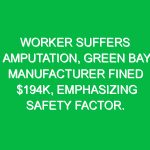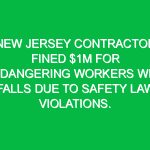Introduction
Fall Protection Planning for Construction Sites is a crucial process to ensure the safety and health of workers on construction sites. In the Health, Safety, and Environment (HSE) domain, it refers to the strategies and measures taken to prevent falls and ensure a safe working environment. Falls are one of the leading causes of injuries and fatalities in the construction industry, making it essential to have a comprehensive plan in place to prevent such incidents.
Importance
Fall Protection Planning is essential for maintaining health, safety, and environmental standards on construction sites. It ensures that workers are protected from potential fall hazards, reducing the risk of injuries and fatalities. This planning helps in creating a safe working environment, boosting the morale of workers, and ensuring compliance with regulatory requirements. By implementing effective fall protection measures, construction companies can prevent accidents, save lives, and avoid costly fines and legal issues.
All Hazards
There are several hazards and risks associated with Fall Protection Planning for Construction Sites. These include:
- Unprotected edges: Open edges on buildings, scaffolding, and other elevated work areas pose a significant risk of falls.
- Improper scaffolding: Scaffolding that is not properly erected or maintained can collapse, leading to falls.
- Unsafe ladders: Using ladders that are not secure or in poor condition can result in falls.
- Openings in floors: Uncovered or unguarded floor openings can cause workers to fall through.
- Slippery surfaces: Wet or oily surfaces increase the risk of slips and falls.
- Lack of guardrails: Areas without proper guardrails can lead to falls from heights.
- Improper use of fall protection equipment: Not using fall protection equipment correctly or failing to inspect it regularly can result in accidents.
Safety Precautions
To mitigate the hazards associated with falls on construction sites, it is essential to follow detailed safety precautions and best practices:
- Install guardrails: Use guardrails around all open edges, platforms, and scaffolding to prevent falls.
- Use proper scaffolding: Ensure scaffolding is erected and maintained according to manufacturer guidelines and safety standards.
- Inspect ladders: Regularly inspect ladders for any damage, and ensure they are properly secured before use.
- Cover floor openings: Cover or guard all floor openings to prevent falls through them.
- Maintain clean surfaces: Keep work areas free of debris, and clean up spills promptly to prevent slips and falls.
- Use fall protection equipment: Ensure workers use personal fall arrest systems, safety nets, or other fall protection devices as required.
- Provide safety training: Educate workers on the proper use of fall protection equipment and the importance of following safety procedures.
Regulations and Standards
Several regulations, laws, and standards govern Fall Protection Planning for Construction Sites. These include:
- OSHA (Occupational Safety and Health Administration): OSHA sets and enforces standards to ensure safe and healthful working conditions for workers. OSHA’s Fall Protection Standard (29 CFR 1926.501) outlines the requirements for fall protection in the construction industry.
- ANSI (American National Standards Institute): ANSI provides guidelines for fall protection equipment and systems, including performance and testing criteria.
- CSA (Canadian Standards Association): CSA sets standards for fall protection equipment and practices in Canada, ensuring worker safety.
- Local building codes: Local building codes may have specific requirements for fall protection on construction sites, which must be followed to ensure compliance.
Tools and Equipment
Several tools, equipment, and technologies are associated with Fall Protection Planning for Construction Sites. These include:
- Guardrails: Guardrails are barriers used to prevent falls from elevated work areas.
- Scaffolding: Scaffolding provides a stable platform for workers to perform tasks at heights.
- Ladders: Ladders are used to access elevated work areas safely.
- Personal Fall Arrest Systems (PFAS): PFAS include harnesses, lanyards, and anchor points that prevent workers from falling or arrest their fall if they do.
- Safety nets: Safety nets are used to catch workers who may fall from heights, providing an additional layer of protection.
- Warning lines: Warning lines are used to mark off areas where fall protection is required, alerting workers to potential hazards.
- Fall protection anchors: Anchors provide secure attachment points for fall protection equipment, ensuring it functions correctly in the event of a fall.
Training and Education
Training and education are critical components of Fall Protection Planning for Construction Sites. Workers need to be properly trained to understand the risks associated with falls and the measures in place to prevent them. Training should cover:
- Hazard recognition: Workers should be able to identify potential fall hazards on the construction site.
- Proper use of equipment: Workers should be trained on how to correctly use fall protection equipment, including harnesses, lanyards, and anchor points.
- Inspection and maintenance: Workers should know how to inspect fall protection equipment for damage and perform regular maintenance to ensure it remains in good working condition.
- Emergency procedures: Workers should be familiar with emergency procedures in case of a fall, including how to respond and provide assistance.
- Regulatory requirements: Workers should understand the relevant regulations and standards governing fall protection on construction sites.
Personal Protective Equipment (PPE)
Personal Protective Equipment (PPE) is essential for tasks involving Fall Protection Planning for Construction Sites. The required PPE includes:
- Hard hats: Hard hats protect workers from head injuries caused by falling objects.
- Safety harnesses: Safety harnesses are worn by workers to prevent falls or arrest falls if they occur.
- Lanyards: Lanyards connect safety harnesses to anchor points, providing a secure attachment.
- Anchor points: Anchor points are secure attachment points for fall protection equipment.
- Safety nets: Safety nets provide a secondary layer of protection by catching workers who may fall from heights.
- Protective footwear: Protective footwear with slip-resistant soles helps prevent slips and falls on construction sites.
- High-visibility clothing: High-visibility clothing ensures workers are easily seen, reducing the risk of accidents.
Emergency Preparedness
Preparing for emergencies related to Fall Protection Planning for Construction Sites is crucial. Emergency preparedness involves:
- Developing an emergency response plan: Create a plan that outlines the steps to take in case of a fall, including how to provide first aid and contact emergency services.
- Training workers: Ensure all workers are trained on the emergency response plan and know their roles and responsibilities in case of an emergency.
- Equipping the site: Provide necessary emergency equipment, such as first aid kits, rescue equipment, and communication devices.
- Conducting drills: Regularly conduct emergency drills to ensure workers are familiar with the procedures and can respond quickly in case of a fall.
- Reviewing and updating the plan: Regularly review and update the emergency response plan to address any changes in the construction site or new potential hazards.
Workplace Design
Workplace design significantly impacts safety concerning Fall Protection Planning for Construction Sites. Key considerations for workplace design include:
- Eliminating fall hazards: Design the construction site to minimize fall hazards, such as unprotected edges and floor openings.
- Providing safe access: Ensure workers have safe access to all elevated work areas through the use of scaffolding, ladders, and guardrails.
- Ensuring proper lighting: Adequate lighting is essential to help workers see potential hazards and navigate the construction site safely.
- Maintaining clear walkways: Keep walkways clear of debris, tools, and equipment to prevent trips and falls.
- Implementing safety zones: Designate specific areas for high-risk activities and ensure these areas are clearly marked and equipped with appropriate fall protection measures.


